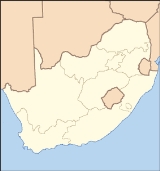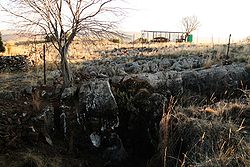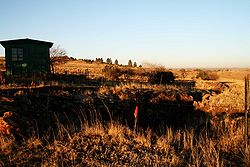
Kromdraai fossil site
Encyclopedia
Kromdraai is a fossil-bearing breccia filled cave located about 2 km east of the well known South African hominid-bearing site of Sterkfontein
and about 45 km Northwest of the City of Johannesburg
, South Africa
. It is situated within the Cradle of Humankind
World Heritage Site
.

 In 1938 The site was brought to the attention of Robert Broom
In 1938 The site was brought to the attention of Robert Broom
by a local schoolboy named Gert Terrblanche who had discovered several hominin teeth. The teeth formed part of a skull that would become the holotype
of Paranthropus robustus
. Broom began excavations at the site that would continue until approximately 1947 and would result in the discovery of numerous hominin remains. Two deposits were noted and named at the site — Kromdraai A and Kromdraai B — the latter being the site where the hominin remains were recovered.
In 1955 C.K. Brain
recommenced work at Kromdraai B and discovered numerous additional hominin remains as well as abundant non-hominin fauna.
In the 1980s Elizabeth Vrba
briefly conducted excavations at Kromdraai B in order to recover additional samples for her work on South African bovids.
In 1993 excavations were re-opened by Francis Thackeray of the Transvaal Museum and Lee Berger
of the University of the Witwatersrand
. They were later joined by teams from Harvard University
and other collaborators. Important results of this work have been the recovery of additional hominin fossils as well as the obtaining of more accurate dates for the site.
fossils dating to between 1.8 and 1.6 Ma.
Sterkfontein
-References:-References:-References:: : : :...
and about 45 km Northwest of the City of Johannesburg
Johannesburg
Johannesburg also known as Jozi, Jo'burg or Egoli, is the largest city in South Africa, by population. Johannesburg is the provincial capital of Gauteng, the wealthiest province in South Africa, having the largest economy of any metropolitan region in Sub-Saharan Africa...
, South Africa
South Africa
The Republic of South Africa is a country in southern Africa. Located at the southern tip of Africa, it is divided into nine provinces, with of coastline on the Atlantic and Indian oceans...
. It is situated within the Cradle of Humankind
Cradle of Humankind
The Cradle of Humankind is a World Heritage Site first named by UNESCO in 1999, about 50 kilometres northwest of Johannesburg, South Africa in the Gauteng province. This site currently occupies ; it contains a complex of limestone caves, including the Sterkfontein Caves, where the 2.3-million...
World Heritage Site
World Heritage Site
A UNESCO World Heritage Site is a place that is listed by the UNESCO as of special cultural or physical significance...
.
History of investigations


Robert Broom
Professor Robert Broom was a Scottish South African doctor and paleontologist. He qualified as a medical practitioner in 1895 and received his DSc in 1905 from the University of Glasgow...
by a local schoolboy named Gert Terrblanche who had discovered several hominin teeth. The teeth formed part of a skull that would become the holotype
Holotype
A holotype is a single physical example of an organism, known to have been used when the species was formally described. It is either the single such physical example or one of several such, but explicitly designated as the holotype...
of Paranthropus robustus
Paranthropus robustus
Paranthropus robustus was originally discovered in Southern Africa in 1938. The development of P. robustus, namely in cranial features, seemed to be aimed in the direction of a "heavy-chewing complex"...
. Broom began excavations at the site that would continue until approximately 1947 and would result in the discovery of numerous hominin remains. Two deposits were noted and named at the site — Kromdraai A and Kromdraai B — the latter being the site where the hominin remains were recovered.
In 1955 C.K. Brain
Charles Kimberlin Brain
Charles Kimberlin Brain , born in Southern Rhodesia in 1931, is an eminent South African paleontologist who has studied and taught African cave taphonomy for more than fifty years.-Biography:From 1965 to 1991, Dr...
recommenced work at Kromdraai B and discovered numerous additional hominin remains as well as abundant non-hominin fauna.
In the 1980s Elizabeth Vrba
Elizabeth Vrba
Elisabeth S. Vrba is a paleontologist at Yale University. Vrba earned her Ph.D. in Zoology and Palaeontology at the University of Cape Town, in 1974. She is well known for developing the Turnover Pulse Hypothesis, as well as coining the word exaptation with colleague Stephen Jay Gould...
briefly conducted excavations at Kromdraai B in order to recover additional samples for her work on South African bovids.
In 1993 excavations were re-opened by Francis Thackeray of the Transvaal Museum and Lee Berger
Lee R. Berger
Lee Rogers Berger is a paleoanthropologist, physical anthropologist and archeologist and is best known for his discovery of Australopithecus sediba and his work on Australopithecus africanus body proportions and the Taung Bird of Prey Hypothesis.-Background:Berger was born in Shawnee Mission,...
of the University of the Witwatersrand
University of the Witwatersrand
The University of the Witwatersrand, Johannesburg is a South African university situated in the northern areas of central Johannesburg. It is more commonly known as Wits University...
. They were later joined by teams from Harvard University
Harvard University
Harvard University is a private Ivy League university located in Cambridge, Massachusetts, United States, established in 1636 by the Massachusetts legislature. Harvard is the oldest institution of higher learning in the United States and the first corporation chartered in the country...
and other collaborators. Important results of this work have been the recovery of additional hominin fossils as well as the obtaining of more accurate dates for the site.
Recovered fossils
Besides the holotype specimen of P. robustus, at the time of the writing of this article 29 hominin specimens had been recovered from Kromdraai B. Many thousands of animal fossils have also been recovered from both Kromdraai A and B.Age of the deposits
Kromdraai B is dated to between approximately 2.0 - 1.6 Ma with the majority if not all the Paranthropus robustusParanthropus robustus
Paranthropus robustus was originally discovered in Southern Africa in 1938. The development of P. robustus, namely in cranial features, seemed to be aimed in the direction of a "heavy-chewing complex"...
fossils dating to between 1.8 and 1.6 Ma.
See also
- Hominids
- Paranthropus robustusParanthropus robustusParanthropus robustus was originally discovered in Southern Africa in 1938. The development of P. robustus, namely in cranial features, seemed to be aimed in the direction of a "heavy-chewing complex"...
- Cradle of HumankindCradle of HumankindThe Cradle of Humankind is a World Heritage Site first named by UNESCO in 1999, about 50 kilometres northwest of Johannesburg, South Africa in the Gauteng province. This site currently occupies ; it contains a complex of limestone caves, including the Sterkfontein Caves, where the 2.3-million...
- List of fossil sites

